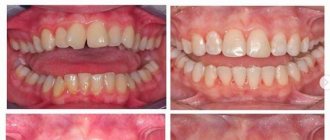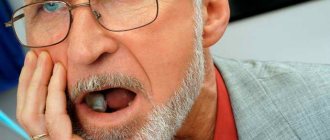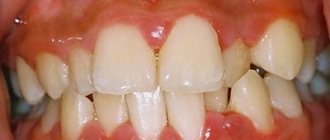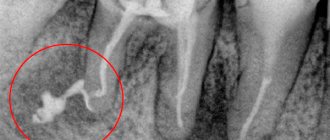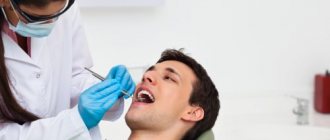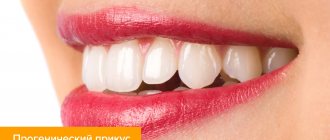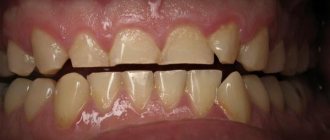A high-quality and rapid wound healing process after tooth extraction depends not only on the professionalism of the doctor who performed the extraction (removal) of the tooth, but on the correct behavior of the patient after the procedure, who must strictly follow the recommendations given by the doctor for the period of healing of the wound surface. If you correctly and clearly follow the advice of a specialist, the recovery process occurs quickly and as painlessly as possible.
For example, patients who do not listen to the recommendations given to them make rinsing movements in the area of the healing wound; this washes out the blood clot, which performs a protective function against the entry of bacteria and microbes, as a result of which there is a high risk of wound suppuration.
In this article we want to give recommendations on what should and can be done after tooth extraction, and what should not be done.
1. A gauze swab on the hole. When can it be taken out?
As a rule, the doctor does not immediately release the patient after removal, but asks him to wait for 15-20 minutes within the clinic to then examine and make sure that everything is in order with blood clotting and the tampon can be removed without fear. In rare cases, keeping the tampon in your mouth may take 30-40 minutes, usually 10-20 minutes. There is no need to keep it longer and it is even dangerous, because bacteria accumulate on it and there is a possibility of infection. There are exceptions, when the wound continues to bleed a little, then the old tampon is replaced with a new sterile one and kept for some time.
For some time, saliva may still be pinkish due to staining with secreted ichor, this should not be alarming, this situation can be distinguished from bleeding. At this moment, saliva can be easily swallowed; there is no need to accumulate it in the mouth.
Overdose symptoms
Symptoms of an overdose of painkillers and NSAIDs depend on the individual characteristics of the human body, the drug taken and its dosage. In some cases, a person may become ill even after taking a therapeutic dose. Therefore, in order to prevent poisoning from local anesthetics and narcotic analgesics, it is necessary to strictly follow the instructions, which necessarily indicate the maximum daily dosages.
Acute poisoning with narcotic analgesics
Painkillers have different effects on the body, so the dose that can lead to intoxication is different.
Signs of poisoning:
- dizzy;
- be sick;
- vomiting occurs;
- It's difficult to breathe;
- weakness, drowsiness;
- increased sweating;
- loss of consciousness;
- pallor, cyanosis;
- the temperature drops;
- constipation, upset stomach;
- weakening of the pulse;
- swelling;
- pressure drop;
- convulsions, tremors.
Among the first signs: lethargy, drowsiness, lethargy, breathing problems. The condition is deteriorating quite quickly. Common complications that arise from an overdose of anesthetic: cerebral edema, pulmonary edema, cardiac arrest, renal failure. A severe overdose of local anesthetics manifests itself in paralysis of the respiratory center. If you do not call an ambulance in time, the risk of death is close to 75%.
Free phone number for a narcologist in Moscow and throughout Russia: 8 (800) 333-20-07. .
It is important to understand that a person who is poisoned by pills can fall into a coma. Even after emerging from this state, irreversible health consequences are possible: mental disorders, dysfunction of certain internal organs.
For recreational purposes, addicts often overdose on painkillers such as Tempalgin or Nurofen to achieve euphoria. Often, to enhance the effect, pharmaceutical drugs are mixed with alcohol and barbiturates, which significantly increases the intoxication of the body and increases the risk of death.
Do you want to know about the cost of services?
8 call our specialist
Non-narcotic analgesics
Non-opioid and non-steroidal anti-inflammatory drugs in pharmacology include drugs that do not have narcotic potential and are not used by drug addicts. These medications are used as anti-inflammatory, antipyretic, painkillers, etc. Regarding doses, for example, if the daily dose, according to the instructions, is 4 grams, then death can occur even after consuming 15-20 g.
Symptoms of Paracetamol overdose:
- liver dysfunction (the medicine is a dangerous toxin for the liver, causes bleeding disorders, hepatitis);
- disruption of the gastrointestinal tract (stomach pain, nausea, vomiting);
- damage to the central nervous system (drowsiness, weakness, lethargy);
- metabolic disorder;
- low pressure;
- renal failure (nephritis and other kidney diseases);
- disruption of the cardiovascular system due to general intoxication;
- encephalopathy.
Acute poisoning can last for 10-12 hours. You can also be poisoned by the drug if you use it for a long time in an increased dosage, as it accumulates in the tissues of the internal organs. Paracetamol is part of many modern drugs sold in pharmacies, including Spazmolex and Pentalgin. These are dangerous pharmaceutical drugs that addicts use to get a “high.” Often such substances are used for the purpose of suicide attempts.
Anonymous 24 hours a day Activity is licensed Patient accompaniment
Full range of narcology services:
- tests
- drug testing
- detox
- encoding
- psychiatry
- binder
- withdrawal symptoms
8+7
Salicylic acid and salicylates
It is quite easy to get poisoned by this common drug among people; it is enough to consume 10-40 g. The dosage of tablets is individual and depends on the condition of the patient’s body. Death is possible in 2% of cases.
Signs of salicylate poisoning:
- your head is spinning, your ears are ringing, your consciousness is confused;
- headache;
- hallucinations, hearing loss;
- chills, cramps;
- euphoric sensations;
- pain in the abdomen, under the ribs, heartburn;
- nausea, vomiting, upset stomach;
- violation of movement coordination;
- excited state;
- deterioration of cognitive functions;
- disruption of the functioning of the heart and blood vessels, internal organs;
- arrhythmia and tachycardia;
- increased fatigue;
- breathing problems, shortness of breath.
When using salicylic acid, for example, Aspirin in large quantities, internal bleeding may occur.
2. After what time can you eat and drink?
After removal, you can drink water. After two hours you can eat. The limiting condition is not to chew rough food on the side of the extracted tooth in the first few days. Hard food can damage the blood clot, which is located in the socket and is needed for wound healing. If the patient experiences an acute feeling of hunger, then no one forbids eating cool yogurt or kefir. In the first days of healing of the hole, it is better to completely avoid eating rough, hard, solid foods, so as not to make strong chewing movements, as well as spicy, salty foods, so as not to irritate the oral mucosa. It is also important to monitor the temperature of food and drinks; they should not be too hot.
Causes of poisoning
More than 12% of drug poisoning and overdose cases involve NSAIDs. Non-opioid analgesics are widely available and can be purchased at any pharmacy, as they are vital supplies. However, it is impossible to buy narcotic painkillers without a prescription. Their free distribution without a prescription is punishable by law. Painkillers often contain codeine, which is sought after by drug addicts.
Why does poisoning occur with painkillers:
- failure to comply with instructions or doctor's prescription;
- incorrect reception;
- doctor's error;
- increasing dosage;
- lack of knowledge about taking medication;
- low body resistance;
- combination with alcohol, drugs, other drugs;
- cumulative effect due to prolongation of the course of treatment;
- taking the drug for recreational purposes;
- intake during pregnancy;
- when attempting suicide.
Among the most dangerous non-steroidal anti-inflammatory drugs is phenacetin, previously contained in such drugs as Sedalgin and Askofen. This analgesic quite often caused the development of allergic reactions and disruption of internal organs. Today, a substance used as an antipyretic, paracetamol, is used to a greater extent in medicine.
If the patient takes the medicine as prescribed and prescribed by the doctor, an overdose of analgesics and local anesthetics occurs quite rarely. However, most often an overdose of anesthetics is used by drug addicts to achieve euphoria. Pharmacy drugs have long become a source of cheap “high” for them.
3.Applying ice.
After tooth extraction in our Center, a specialist will give you ice specially prepared for such procedures to apply in the first hours after extraction. Ice is applied for a certain time, at certain intervals, which the doctor will instruct you about. At home, this procedure will need to be continued for some time (the first few hours after removal). This is done in order to minimize or completely eliminate tissue swelling.
Under no circumstances should you heat the area in the area of the extracted tooth; in this case, suppuration will develop.
How to use
All medications containing paracetamol must be taken 20 minutes after meals and washed down with plain water. For this purpose, it is not recommended to use coffee or other drinks containing caffeine, since this substance, in combination with paracetamol, has a negative effect on the liver.
When using the drug without a doctor's prescription, the maximum single dose is 1 gram. For toothache, take it up to 4 times a day.
The greatest caution should be exercised when treating children with the drug. Self-medication in this situation is contraindicated. The best solution would be to call a doctor or an ambulance to see the child.
The maximum time during which you can take paracetamol is 3 days. In addition, it is generally prohibited for children under three years of age.
When calling a doctor, you need to tell him about the presence of chronic diseases and medications currently taken. No significant interactions of paracetamol with other drugs were found, but it is safer not to take the drug simultaneously with sodium valproate and sodium barbiturates.
6. Medications after removal.
After the procedure, the doctor prescribes a number of medications to take. Under no circumstances should you take any medications on your own, without consulting a doctor.
Painkillers should be taken in case of pain, at intervals and in the amount recommended by the doctor. Each case is individual; it happens that the patient does without taking painkillers.
Antibiotics. In some cases, after removal, antibiotics are prescribed for 5-7 days. As a rule, these are situations when the doctor removes a tooth in the stage of inflammation, complex extraction or removal of several units of teeth. Only a specialist surgeon decides whether to take antibiotics or not.
Antihistamines. Reduces the likelihood of swelling.
Antiseptics. Used as a rinse. BUT, remembering that rinsing movements are prohibited in the first days. A small amount of solution is taken into the mouth and simply held in the mouth, then calmly spit out. Such baths must be done if the tooth was removed during the inflammation phase, if the flux was exposed, if there are teeth affected by caries in the oral cavity.
When to see a doctor
Contact your healthcare provider if you experience the following symptoms:
- pain that does not decrease/increase on the 3rd day after surgery,
- numbness persists for 2 days after surgery, does not go away a week after implantation and only intensifies, spreading over the entire face,
- a sharp increase in facial swelling on the 2-3rd day or after it has already subsided,
- a sharp increase in body temperature or it does not subside 3-4 days after surgery,
- when pressing on the implants, unpleasant sensations, sharp pain occur,
- the seams came apart
- redness of the gums and bleeding that does not stop after 2-3 hours,
- discomfort and sharp pain when pressing on the area of installed implants 7 days after installation,
- pain after fixing the prosthesis, teeth do not close together, it is impossible to chew even soft food,
- The prosthesis became mobile and some of the teeth chipped.
7.High blood pressure.
In patients with high blood pressure, there is a risk that the wound may bleed longer than usual. In this case, you need to regulate the pressure by taking appropriate medications to reduce it. In our SDent dental medical center, even before the start of manipulations, the doctor always finds out the main points about the general health of the patient. If the patient has hypertension, the specialist knows about this problem in advance and then gives the necessary recommendations appropriate to the case.
If you have dental implants, it is prohibited
- use electric toothbrushes, since vibrations and excessive pressure during the cleaning process, especially in the first months after implantation, can lead to poor fixation of implants,
- You should also not use dental floss, especially if only a few implants were installed to replace living teeth. After implantation, the gums become less sensitive and when flossing you may not feel when it is time to stop - this can damage the tissue, which will lead to bacteria getting into the area around the installed implants. And this is already fraught with their possible rejection,
- carry out hygienic cleaning in any dentistry - it is very important that the hygienist knows how and understands how to carry out the procedure in the presence of dental implants,
- Eating foods that are too hard: The denture can be damaged if you bite off hard objects with your teeth, chew pencils, or crack open nuts. Of course, it can be restored, but it is better to prevent such situations from developing.
You will forget about dental problems for the rest of your life! Together with you, we will select the most optimal implantation method and give it a LIFETIME guarantee.
Free consultation
8.What happens to the sutures after removal.
After the tooth is removed, the surgeon places sutures on the wound surface. This promotes faster healing, reduced pain, less risk of inflammation, minimizes the risk of bleeding, and protects the blood clot from falling out.
At the SDent clinic we use the most modern and safe materials. The thread with which the surgeon sews the edges of the hole is self-absorbing. But during the process, the ends of the thread can cause discomfort to the patient and interfere with the oral cavity. Therefore, for the comfort and safety of the patient, the doctor always sets an appointment date for examination and removal of sutures in approximately 10 days.
Paracetamol as a remedy for toothache
The international name of the drug is acetaminophen. For several decades, paracetamol has been used both in the CIS and in other countries.
Some medicines based on paracetamol:
- "Paracet"
- "Calpol"
- "Panadol"
- "Tylenol"
- "Efferalgan"
- "Opradol"
- "Akamol"
- "Mexalen"
- "Volpan"
Various forms of paracetamol packages can be found in pharmacies for free sale.
The forms of release of drugs based on paracetamol are also very diverse: ordinary tablets, capsules, ampoules, elixirs, syrup. The product is available at literally any pharmacy without a prescription. This method of dispensing gives people the erroneous illusion that the medicine is completely safe for health.
After tooth extraction, you should not do the following.
- In the first couple of days, taking a hot bath is excluded, only a warm shower.
- During sleep, you need to be careful not to lie on the side where the tooth was removed, this provokes the appearance of swelling.
- Visiting the gym and active physical activity should be postponed in the first days.
- Do not touch the wound with your tongue or foreign object.
- Do not open your mouth very wide, do not use active chewing and facial movements to avoid the sutures coming apart.
- Aspirin is not suitable as an anesthetic due to the fact that it has a thinning effect on the blood and may cause bleeding and hematoma.
- Do not rinse during the first few days. This can negatively affect the loss of a blood clot from the socket and the occurrence of inflammation.
For more information and to make an appointment with a specialist, call:
+7,
Does paracetamol relieve acute toothache?
The product can successfully cope with any pain syndrome, including headache or toothache. What sets Paracetamol apart from its competitors is its good absorption: it ends up in the blood, quickly passing through the gastrointestinal tract. The medicine begins to act approximately half an hour after administration. It does not belong to hormonal (steroid) drugs.
Paracetamol was previously thought to have anti-inflammatory properties. But the results of recent research in this area indicate that the anti-inflammatory effect of the drug is minimal. At the same time, this does not mean that the drug can be taken for a long time without any control.
It is necessary to be aware that paracetamol is intended only to combat the symptoms of diseases, but has absolutely no effect on the source that caused the pain or fever.

